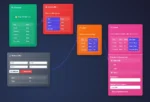
by tyler garrett | May 24, 2025 | Data Processing
As enterprises grow and data proliferates across global boundaries, ensuring the efficient operation of data pipelines across data centers is no longer just smart—it’s essential. Carefully crafting a cross-datacenter pipeline topology allows businesses to minimize latency, optimize costs, and maintain service reliability. For organizations stepping into international markets or scaling beyond their initial startup boundaries, understanding how to architect data transfers between geographically dispersed servers becomes crucial. At our consultancy, we have witnessed firsthand how effective topology design can dramatically improve operational efficiency, accuracy in analytics, and overall competitive advantage. In this blog, we’ll delve deeper into what businesses should know about cross-datacenter pipeline topology design, including best practices, common pitfalls, innovations like quantum computing, and valuable lessons learned from successful implementations.
The Importance of Datacenter Pipeline Topology
At a basic level, pipeline topology refers to the structured arrangement determining how data flows through various points within a system. When we expand this concept across multiple data centers—potentially spread across regions or countries—a thoughtful topology ensures data pipelines perform efficiently, minimizing latency issues and balancing workloads effectively.
Without a well-designed topology, organizations risk bottlenecks, data inconsistencies, and slow delivery of vital analytics insights. Decision-makers often underestimate the strategic significance of how data centers communicate. However, as proven in many successful ETL implementations, adopting strategic pipeline topology layouts enhances an organization’s abilities to leverage real-time or near-real-time analytics.
Effective topology design is especially critical where sophisticated visual analytics platforms like Tableau are deployed. As experts in the space—highlighted within our advanced Tableau consulting services—we frequently observe how datacenter topology profoundly impacts dashboard load speeds and overall user satisfaction. Ultimately, topology choices directly affect how quickly analytics become actionable knowledge, influencing both customer-centric decision-making and internal operations efficiency.
Optimizing Data Flow in Cross-Datacenter Pipelines
Optimizing data flow hinges on a few core principles: reducing latency, efficiently balancing traffic loads, and ensuring redundancy to support consistent uptime. Organizations that wisely choose data center locations can take advantage of strategically placed clusters, minimizing distances and thus significantly cutting latency. For instance, enterprises pursuing analytics for improving community wellness and safety—similar to the initiatives detailed in our featured resource on data analytics enhancing public safety in Austin—depend heavily on real-time data availability, making latency reduction crucial.
A common challenge is maintaining necessary synchronization among data centers. When properly synchronized, modern technologies like automated system snapshotting and backups become swift tasks rather than time-consuming activities. Businesses employing solutions such as automatic snapshots (as explained in our resource on Tableau server automated dashboard images) realize substantial gains in operational efficiency and recovery speed.
Additionally, complexity often compounds with the addition of multiple multi-cloud providers. Integrating hybrid cloud strategies demands a comprehensive understanding of topology best practices. Leveraging cloud-native applications helps organizations target critical optimizations and align data flows more effectively. Pipeline architects must constantly reassess and fine-tune routing rules, interpreting traffic analytics throughout production environments.
Harnessing Advanced Technologies for Topology Design
Modern technologies open novel opportunities and innovations for enhancing cross-datacenter pipeline topology designs. Traditionally, IT teams primarily relied upon conventional relational database technologies. However, increasingly organizations are exploring alternatives like Node.js to streamline processes efficiently. Our insights into streamlining data pipelines with Node.js clearly illustrate the significant performance improvements possible using event-driven, non-blocking platforms. Integrating node-based pipelines into your topology can substantially lower latencies and increase pipeline reliability—key aspects for organizations managing large-scale international data workflows.
Beyond traditional server-based approaches, cutting-edge innovations are approaching commercialization rapidly. Quantum computing, for example, is positioned as a transformative force that could revolutionize real-time analytic capabilities. In our resource detailing the impact of quantum computing, we explored how quantum computing could revolutionize data processing, highlighting significant enhancements in data handling speeds and computational efficiency. As quantum capacities mature, pipeline topology designs will become even more sophisticated, leveraging quantum algorithms to process workloads faster, smarter, and more efficiently than ever before.
By investing today in modern architectures that leave room for rapid technological advancements, organizations set themselves up for ongoing success and future-proof their infrastructure for new innovations and opportunities.
Avoiding Common Pitfalls in Pipeline Topology Implementations
Effective topology design also involves recognizing mistakes before they impact your organization negatively. One of the most common pitfalls is not fully considering redundancy and failover processes. Reliability is paramount in today’s data-driven market, and system outages often result in significant lost opportunities, damaged reputations, and unexpected expenses. Implementing multiple availability zones and mirrored environments helps teams maintain continuous operation, thereby significantly reducing downtime and mitigating potential disruptions.
A second notable pitfall is resource misallocation—over or under-provisioning of infrastructure resources due to inadequate workload forecasting. Decision-makers often assume that creating redundancy or buying excess capacity translates into efficient design. However, this approach can easily result in increased operating costs without commensurate performance gains. Conversely, undersized architectures frequently lead to performance bottlenecks, causing frustrated end-users and intensifying demands on IT personnel.
Finally, another frequent oversight is insufficient monitoring and failure to adequately utilize real-time diagnostics. Businesses need appropriate analytics embedded into their pipelines to fully understand resource usage patterns and data traffic issues. Implementing these analytical insights encourages smarter decision-making, driving continuous improvements in data pipeline reliability, latency, and resource utilization.
Strategically Visualizing Pipeline Data for Enhanced Decision-Making
Visual analytics take on special importance when applied to datacenter topology designs. Effective visualizations allow stakeholders—from C-suite executives to technical architects—to quickly spot potential choke points, qualifying issues such as overloaded or underutilized nodes. Insights derived from powerful visualization tools facilitate faster resolutions and better-informed infrastructure optimizations. Techniques described in our guide to creative ways to visualize your data empower both business and technology personas to stay aligned and proactive about potential issues.
Organizations investing in thoughtfully created data visualizations enjoy greater agility in handling challenges. They become adept at identifying inefficiencies and planning proactive strategies to optimize communication across geographies. Visual data clarity also enables quicker reactions to unexpected scenario changes, allowing teams to dynamically manage data pipelines and make better-informed capacity-planning decisions.
However, enterprises should also be mindful that visual analytics alone don’t guarantee sound decision-making. Effective visualization should always complement strong underlying data strategies and informed decision processes—an idea elaborated in our analysis on why data-driven doesn’t always mean smart decisions. Deploying contextual knowledge and insight-oriented visualization dashboards accelerates intelligent, purposeful decisions aligned with business goals.
Future-proofing Your Cross-Datacenter Pipeline Strategy
The world of data analytics and technology continuously evolves. Organizations that adopt a forward-looking stance toward pipeline topology ensure their competitive edge remains sharp. Your pipeline topology design should be scalable—ready for regulatory changes, geographical expansion, and increased data volumes. Future-proofing means designing architectures that allow companies to easily incorporate emerging technologies, optimize operations, and handle complexity without significant disruptions or costly system-wide restructuring.
In particular, companies should closely watch emerging tech like quantum computing, new virtualization technologies, and heightened security requirements to shape their strategic roadmap. Being prepared for innovations while maintaining flexibility is the hallmark of intelligent architecture planning.
As a consultancy focused on data, analytics, and innovation, we continually advise clients to adopt industry best practices, incorporating new technology developments strategically. Whether businesses confront particular error-handling scenarios (like those illustrated in our technical article on resolving this service cannot be started in safe mode errors) or aim to explore transformative opportunities like quantum computing, prioritizing flexibility ensures a robust and future-ready pipeline topology.
Tapping into professional expertise and proactively planning helps businesses to design cross-datacenter pipeline topologies that become intelligent catalysts of growth, efficiency, and innovation—remaining agile despite the inevitable shifts and complexities the future brings.

by tyler garrett | May 23, 2025 | Data Visual
In today’s dynamic business environments, complex data visualizations are increasingly critical to informed decision-making. As leaders accustomed to thriving in fast-paced industries, you’ve likely experienced the challenge of communicating complex messages with clarity and effectiveness. Multi-state visualizations—those interactive experiences that shift seamlessly from one view or scenario to another—are a powerful solution. However, without thoughtfully implemented view transitions, these powerful visualizations risk confusing users and hindering your organization’s ability to leverage deep insights. In this comprehensive guide, we’ll explore strategic methods for implementing view transitions in your multi-state data visualizations, allowing stakeholders to intuitively grasp changing information quickly, make informed data-driven choices, and achieve optimal business outcomes across operations. Whether you’re assessing market trends, exploring customer segmentation strategies, or analyzing historical sales data, smooth view transitions ensure your visualizations remain impactful guides rather than sources of confusion.
Why View Transitions Matter in Data Visualization
At the heart of impactful data visualization lies clear, intuitive communication. Transforming data sets into actionable insights often involves creating visualizations that offer multiple states or perspectives, such as toggling between current and projected scenarios or comparing segmented demographic data. Without seamless transitions between these views, users struggle to grasp context or understand progression, diluting the very value visualizations aim to deliver. Thoughtfully designed transitions, on the other hand, engage attention, provide users a subtle yet clear orientation, and ease cognitive loads, allowing stakeholders to confidently interpret presented insights.
Consider scenarios like transitioning smoothly between segments when segmenting your customer data. With smooth transitions, stakeholders can understand why one segment leads to specific outcomes without needing additional explanation. Whether tackling complex historical sales analysis, identifying aspects of a DataOps maturity assessment, or pinpointing trends via multi-modal data fusion, transition animations provide critical visual continuity and comprehension.
As visualization complexity scales alongside increasingly comprehensive analytics and reporting requirements, smooth transitions transform technical presentations into engaging storytelling experiences. Business leaders, analysts, and engineers alike rely heavily upon visualization intelligence to direct strategy confidently. Neglecting view transitions risks undermining rigorous analyses, causing misinterpretations, or sending leaders chasing the wrong insights. Strong graphical transitions thus become indispensable.
Core Principles for Effective Transition Implementation
When approaching multi-state visualizations, it’s essential to ground your implementation strategy in certain key principles designed to ensure clarity, continuity, and user orientation. Adoption of proven transition best practices guarantees that each interactive element reduces cognitive friction instead of amplifying user confusion.
1. Maintain Contextual Continuity
Context builds comprehension, serving as the visual backbone guiding users effortlessly through multiple visualization states. Your visualizations should retain clearly recognizable reference points at all times. For example, familiar axis labels, stable visual encodings, or reference lines that persist as users move from one state or dataset to another ensure users understand where they are and how one visualization state relates to another.
This principle becomes particularly crucial when analyzing complex information through advanced methods like multi-modal data fusion strategies. Maintaining constant visual anchors helps users easily spot and interpret changes across complex data scenarios and measurements, providing confidence in analytical interpretation and decision-making.
2. Utilize Thoughtful Animation Timing
The timing of your transitions dramatically impacts user comprehension. Too quick a movement and viewers fail to register meaningful changes; too slow, and stakeholder attention drifts, diminishing overall interaction quality. Optimal timing allows for visual recognition of differences without lengthy wait periods. Depending upon visualization complexity—from simple trend lines to intricate Machine Learning visualizations or production machine learning pipelines—your transitions should delicately balance speed and clarity, enhancing user understanding and comfort.
Testing across multiple user profiles within your organization (analyst, executive, non-technical leaders) helps calibrate this balance accurately, ensuring an intuitive, engaging transition from one visualization perspective to another.
3. Minimize Visual Complexity During State Shifts
Complex transitions, cluttered visuals, or unnecessary special effects risk obscuring the most critical insights. Effective transitions always prioritize function over aesthetic form. Carefully constructed transitions remove distractions and emphasize essential informational shifts. For instance, when visualizing large-scale data such as those challenges presented in situations where you might be asking “What happens when you give engineers too much data?“, it becomes even more crucial that visualization transitions are clean, direct, and simplified. Clear transitional pathfinding reduces cognitive fatigue, improving user retention and improving business strategy clarity.
Challenges and Overcoming Common Pitfalls
Implementing effective transitions can appear deceptively simple yet frequently faces real-world technical challenges. By proactively acknowledging common pitfalls ahead of your implementations, you position your organization for efficient execution and more strategic outcomes.
Managing Performance with Large Data Sets
Modern enterprises increasingly generate vast amounts of data, leading visualization solutions to potentially slow, degrade performance, or outright fail. When connecting visualizations to sources like Google Sheets or CSV files, teams often grapple with limitations or issues (see this related analysis on a key product limitation: connecting to large Google Sheets files). To effectively manage these structural limitations, teams should adopt pragmatic strategies such as thoughtful data aggregation, optimized queries, caching, or data warehousing to streamline multi-state visualization transitions efficiently.
If your team faces ongoing performance degradation issues stemming from large transactional databases or analytics data sets, it signals a more extensive underlying architectural issue. It could be one of many signs suggesting your business needs a dedicated data warehouse solution.
Accounting for User Familiarity and Analytical Capability
Users’ familiarity with visual analytics tools varies significantly. While some stakeholders may effortlessly navigate complex transitions, others find even basic interactive visualizations intimidating. Accessibility comes from understanding your audience, establishing personalized training programs, empowering usability exploration, and designing transitions within your team’s analytical capabilities. Continuous monitoring, iterative feedback loops, and adaptive implementation ensure visualization success across diverse stakeholder groups, boosting organizational decision-making competency.
Leveraging Advanced Techniques and AI Integration
Today’s sophisticated visualization transitions increasingly leverage Artificial Intelligence and Machine Learning, enabling predictive state transitions and enhancing analytic clarity. Predictive modeling capabilities integrated into visualization layers allow proactive adjustment, adaptive analytics flows, or automated recommendation insights. At Dev3lop, a leader in innovation and analytics strategy, our AI agent consulting services empower organizations to strategically implement AI-driven visualization transitions, dramatically heightening visualization effectiveness.
Such integrations usher visualization analytics into new realms, automatically highlighting emerging trends, anticipating critical decision junctions, or guiding stakeholder attention proactively. Regardless of technical complexity in AI voicing proactive analytics, strategic visualization transitions consistently amplify stakeholder confidence, enhance organizational receptivity, and elevate the overall value of analytical insights enterprise-wide.
Driving Strategic Outcomes through Strategic Transitions
Changes to visualization states frequently reflect broader strategic decisions, problem-solving processes, competitive adaptations, or operational shifts. Clear and intuitive view transitions elevate stakeholder comprehension, faster navigation to critical insights, and significantly enhance organizational decision-making agility within fast-paced environments.
Effective view transitions not just improve analytics or communication—they drive strategic outcomes. Clearly structured and thoughtfully designed visual transitions translate complex data phenomena directly into understandable, actionable strategies, allowing executives and analysts alike to swiftly grasp underlying narratives. Organizations investing actively into structured visualization transition implementation position themselves advantageously to maximize business impact, innovate more effectively, and outperform their peers.
Conclusion
In implementing view transitions, your organization enhances clarity, improves stakeholder engagement, and amplifies the strategic impact of data visualization tools. Thoughtful transition implementation addresses critical business challenges like complexity management, comprehensive analytic explorations, and proactive infrastructure decision-making. Strategic use of view transitions within multi-state visualizations enables your enterprise to capitalize fully on its analytical potential, turning complex data streams into clear, actionable intelligence.
Thank you for your support, follow DEV3LOPCOM, LLC on LinkedIn and YouTube.

by tyler garrett | May 21, 2025 | Data Processing
Imagine rolling out your latest data pipeline update directly into production without breaking a sweat. Sounds risky? Not if you’re embracing canary deployments—the strategic practice tech giants like Netflix and Google trust to safely test in real-world conditions. Canary deployments let your team verify quality and performance of data workflows incrementally, allowing you to confidently push updates without missing insight or causing downtime. As experts deeply entrenched in data engineering and analytics, we understand how mission-critical pipeline reliability is—but innovation requires taking calculated, informed risks. Let’s explore how canary deployments unlock production testing potential, enabling teams to manage technical complexity led by smarter risk-taking and pragmatic strategy.
What are Canary Deployments in Data Pipelines?
Canary deployments are controlled rollouts where a small fraction of users or workloads initially receive an updated system. Rather than launching changes to your entire user population at once, this approach gradually introduces updates, letting your technical teams monitor how the enhanced functionality behaves in real-world scenarios. For data pipelines—often complex and tightly woven into core analytic processes—adopting canary deployments lets teams confidently test changes and innovations while mitigating risk and quickly learning what improvements are really effective.
In practical terms, a portion of jobs, workflows, or events pass through the updated data pipeline infrastructure first—in essence, becoming the early “canary” who tests the waters before full rollout. By closely observing how these early cases perform, teams quickly discover unforeseen problems without compromising their entire system. Leveraging this incremental launching technique allows informed and confident decision-making.
For organizations seeking a robust method of improving data engineering practices, implementing canary deployments offers tangible benefits across reliability, innovation speed, and responsiveness. Our expertise in core data engineering consulting services illustrates repeatedly how strategic canary deployments have allowed clients to unlock productivity gains and foster a safer testing environment directly in production.
Why Implement Canary Deployments?
Reducing risk and downtime
Risk reduction is one of the primary drivers behind canary deployments. Deployments at scale always carry potential risks like bugs, latency issues, or problematic data transformations becoming live—and any downtime equates to lost dollars, reputational harm, and wasted resources. Canary rollouts significantly lessen this risk by limiting exposure to changes until thoroughly tested under live scenarios. Teams gain valuable visibility without placing their entire pipeline architecture at stake.
Meaningful measurement and observability
Canary deployments align perfectly with a proactive observability strategy. Because only a portion of the system is running the updated code, targeted monitoring during canary testing phase helps identify performance bottlenecks and potential issues. For better clarity on crucial measurements, integrating sound observability into your pipeline workflows is foundational. Dive deeper into defining and monitoring essential performance metrics through our guide on the Golden signals for data pipelines.
Faster innovation cycles
The strategic agility enabled by canary deployments accelerates your innovation. With confidence in safe deployment techniques, developers iterate quickly knowing that any faults will remain isolated and manageable. This approach seamlessly integrates into existing Continuous Integration and Continuous Delivery workflows. Implementing canary deployments complements robust DevOps practices; we recommend our comprehensive guide on CI/CD pipeline building to learn more about establishing modern deployment standards.
Implementing Canary Deployments for Data Pipelines
Designing your workload partition strategy
Determining your initial canary workloads is critical. Start small with clearly defined boundaries, selecting data jobs or pipelines representing a proportionate, representative traffic sample. Taxes on pipeline resources, unique workload characteristics, and key functional usages should shape your chosen canary test group. For example, a financial analytics pipeline might initially choose one type of transaction or one regional dataset for their canary deployment.
Robust execution and automation
Automation is your ally when launching canary deployments. Automation standardizes testing processes, reduces risk further, and lets your team quickly replicate and scale successful deployments systematically. Modern data engineering solutions frequently leverage automation tools such as Apache Airflow workflows. Pipeline automation integrates seamlessly with database operations; to optimize your data grouping and aggregation strategies implemented during canary testing, explore our insightful guide on grouping and aggregating data in SQL.
Real-time feedback loops and observability
Observability ensures you capture early and distinct feedback from pipeline changes. During canary deployments, make sure your observability dashboards measure both the canary system and original production system simultaneously. Integrating enhanced metadata tracking can also provide crucial context about affected pipeline components. For Tableau Server environments, consider improving metadata collection methods in your pipeline performance analysis according to our guide on how to improve Tableau Server metadata collection with Colibri dashboards.
Addressing Challenges and Best Practices
As with any technological approach, successful canary deployments depend on careful planning and adherence to best practices. Potential challenges include ensuring adequate testing environments, designing representative experiments, and effectively managing increased complexity. Effective planning—considering factors such as data regulations, sensitive information handling, and timeline controls—mitigates these challenges dramatically.
Human-centered design significantly plays a role in overcoming organizational and technical challenges. Analyzing user experience and stakeholder expectations at the ecosystem level can prevent issues resulting from misunderstood or poorly adopted processes. Explore the benefits of adopting a human-centered design in data analytics to foster acceptance, understanding, and product adoption as your pipeline changes evolve in productive synergy with users.
Additionally, properly managed database environments underpin successful pipeline deployments. Setting up and maintaining the foundation of your database infrastructure is fundamental; you’ll find useful recommendations in our step-by-step guide on how to start MySQL locally to effectively support your team’s early pipeline development and testing phases.
Visualizing Canary Deployment Outcomes
An essential component of successful canary deployment strategies includes translating data into effective, impactful visual narratives. Clear visual analytic insights gathered from a canary deployment help stakeholders quickly grasp measured outcomes and impacts. Effective dashboarding simplifies complex scenarios and fosters timely communication among decision-makers. For deeper insights on techniques to communicate analytical findings, check out our extensive resource on creating effective and visually appealing data visualizations.
Remember, visually tracking performance, alerts, and diagnostic analytics for your canary deployment helps your team rapidly make informed decisions. When issues surface, visual tools lead to rapid diagnosis and accelerated resolution, ultimately allowing you to maximize the value hidden within successful canary deployment results.
Canary Deployment in Your Future Pipeline Strategy
Testing in production may seem daunting—but expertly executed canary deployments provide your data engineering teams a safe framework, empowering continuous exploration and improvement to data workflows. By integrating incremental feature launching practices, you minimize disruptions, confidently monitor pipeline outcomes, and accelerate internal technical innovations. If data-driven agility, reliability, and confident technical strategy are your organization’s goals, embracing canary deployments is an essential step toward the future.
Ready to explore advanced deployment strategies uniquely tailored to your pipeline environment? Reach out to our experts—we’re dedicated to building agile, innovative pipeline solutions that open new opportunities, reduce complexity, enhance visibility, and elevate business outcomes.

by tyler garrett | May 20, 2025 | Data Processing
In the dynamic landscape of data-driven businesses, speed and accuracy are paramount. Organizations increasingly rely on complex data transformation processes to distill their raw data into actionable insights. But how can teams deliver consistent, reliable data transformations quickly, without compromising quality? The answer lies in embracing Continuous Integration (CI) practices tailored specifically for data transformation logic. Leveraging CI principles for data pipelines doesn’t just ensure error-free deployments—it provides agility, enhances reliability, and enables teams to innovate faster. Through our extensive experience tackling challenging use-cases from event-driven architectures to semantic modeling, we’ve found that implementing a continuous integration strategy serves as a strategic advantage for our clients, transforming uncertainty into competitive insights.
The Importance of Continuous Integration in Data Transformation
Data transformations sit at the critical intersection between raw data and meaningful analytics. Missteps here—like outdated logic or uncaught errors—can cascade quickly into inaccurate or misleading reporting, harming trust across the entire organization. Continuous integration addresses these concerns proactively. With each change to your transformation code, CI processes automatically build, test, and validate transformations against predefined quality thresholds. This helps catch errors before they reach production, significantly reducing risk. For teams using advanced real-time aggregation techniques, proactive validation enables robust analytics workflows that users can trust.
A disciplined Continuous Integration framework also provides valuable audit trails. Transparency into transformation logic version histories assists analytics leaders looking to identify potential data quality issues and enables developer teams to revert changes confidently when needed. Moreover, CI encourages healthy practices like modularizing your transformation logic, managing dependencies clearly, and maintaining up-to-date documentation. Leveraging CI proactively fosters a culture of quality and responsibility, essential for data teams aiming for rapid innovation without sacrificing accuracy.
Building a Robust Continuous Integration Pipeline for Data Transformation Logic
A robust CI pipeline tailored specifically for data transformation logic requires careful planning and design. Typically, this includes clearly defined source-code repositories, automated code builds, rigorous unit and integration tests, and continuous quality assessments. Structuring your pipeline provides clarity and consistency. Version control systems like Git ensure visibility, easy collaboration between development and analytics teams, and trusted rollback capabilities. Automation tools such as GitHub Actions, GitLab CI/CD, Jenkins, or Azure DevOps help integrate validation tests directly into your workflow, smoothing out the path from development to deployment, and safeguarding against errors.
Unit tests play a vital role, testing your transformation logic against expected results to ensure functionality doesn’t degrade over time. Managing out-of-order event data effectively is a common challenge engineers face in analytics pipelines; robust integration tests paired with careful unit testing can ensure your data transformations handle these challenges gracefully. In addition to automated testing, advanced validation includes assessing the correctness and completeness of the generated output, checking functionality against historical data snapshots, and benchmarking performance against expected runtime metrics under realistic data volumes. Together, these elements build confidence, enabling quick iterations on valuable analytics logic and empowering decision-makers with reliable insights for strategic moves.
Addressing Complexities with Domain-Driven Data Design Methods
Large organizations often face significant complexity managing multiple domains and business contexts within their data pipelines. Implementing Continuous Integration in these environments demands disciplined strategies. One particularly beneficial approach that complements CI practices is Domain-Driven Data Design. Borrowing concepts popularized in software engineering, this method encourages defining clear boundaries (“bounded contexts”) around data transformation logic related to distinct business areas. Teams can independently develop, test, and integrate their respective transformation logic components without conflicts or unexpected dependencies arising.
Integrating Domain-Driven Data Design into your Continuous Integration workflows prevents misaligned data transformations and enhances transparency. Data architects and analytics leaders gain a clearer lens on their organization’s analytics lifecycles, leading to better governance practices. As organizations iterate and scale, aligning CI tooling with explicit business contexts ensures that each team can release and deploy confidently, reliably responding to evolving business demands without jeopardizing stability or accuracy across different business domains.
Semantic Layers and CI: Ensuring Consistency and Accuracy
Robust data analytics relies upon clarity and consistency—not simply in execution logic, but also in vocabulary and meaning. This necessity underscores the importance of developing and maintaining a semantic layer that empowers stakeholders to interpret data analytics uniformly. Continuous Integration can directly facilitate this strategy by embedding semantic validations and consistency checks within the automated CI pipeline. Incorporating metadata-driven validations ensures that data transformations comply with pre-agreed semantic standards, and spot anomalies early, avoiding misunderstandings and rework.
Failure to maintain semantic consistency can result in misleading analytics output, costly analytics re-engineering efforts, and lost stakeholder trust across executive leaders and analytics teams alike. By formalizing semantic measures and standards directly into continuous integration processes, organizations can avoid such pitfalls. Semantic layers provide particularly powerful transparency measures in executive dashboards, ensuring leaders trust their analytics insights and can confidently leverage executive dashboards that drive real strategic decisions.
Applying CI to Advanced Analytics Use Cases
As organizations expand their analytics capabilities, advanced features become increasingly standard in data transformation pipelines. Techniques like Natural Language Processing (NLP), sentiment analysis, real-time analytics, and predictive analytics introduce additional complexity. Implementing Continuous Integration addresses these advanced use cases robustly and proactively. Automated tests validate robust performance metrics, ensuring consistent reliability even across real-time streams or unstructured datasets. For example, in implementing complex pipelines for sentiment analysis with NLP, Continuous Integration helps verify accurate analytical outcomes at each iteration, ensuring machine-learning pipelines maintain accuracy and scalability over time.
Teams leveraging real-time analytics on event streams can confidently deploy changes to complex windowed aggregation logic, knowing proactive testing practices validate boundaries, timestamps, and traceability of events correctly. As transformation workflows incorporate emerging technologies like real-time windowing, NLP, and sentiment analysis, CI workflows become a prerequisite capability. The cumulative result is an efficient analytics environment, trusted by executives and essential for fostering innovation, often enabling teams to confidently experiment with innovative analytics concepts in vibrant tech communities like Austin, Texas.
Enhancing Legacy Data Transformation Systems with Continuous Integration
Many organizations continue relying heavily on older data transformation infrastructure, facing significant obstacles to replacing wholesale due to budget constraints or concerns over business continuity. This scenario often results in data teams struggling with maintaining outdated systems and slowing innovation. Continuous Integration provides valuable capabilities for enhancing these legacy systems strategically, giving teams incremental and impactful ways of improving quality and maintaining productivity without necessitating disruptive rewrites (see our insights on how to innovate inside legacy systems without replacing them).
Introducing continuous automated validations into existing legacy pipelines and transformation processes helps maximize stability and spot hidden issues early. Teams employing incremental CI processes can modernize parts of their logic a piece at a time, greatly reducing risk and maximizing flexibility. Leveraging smart design strategies to integrate Continuous Integration practices, organizations transform rigid pipelines into more agile, stable platforms that enable incremental updates, continuous innovation, and enhanced trust from analytics stakeholders.
Final Thoughts: Realizing the Value of CI for Data Transformation
Adopting Continuous Integration methodologies tailored specifically towards data transformation logic opens a beneficial pathway for organizations seeking innovation and analytical trust. Ensuring meticulous, automated validation at every step, CI strategically safeguards your analytics investments, enabling confident, rapid iteration. Paired with robust domain-driven design strategies, strong semantic layers, and insight-driven testing & validation, CI is no longer just for software—it’s an indispensable element of today’s effective data analytics ecosystem. As consultants deeply experienced in data analytics and MySQL and database consulting services, we consistently help our clients embrace CI practices, thereby delivering transformative, confident analytics that drive meaningful organizational outcomes.
Tags: Continuous Integration, Data Transformation, Data Pipelines, Domain-Driven Design, Real-Time Analytics, Data Analytics Strategy

by tyler garrett | May 19, 2025 | Data Processing
In an era where data pipelines fuel crucial business decisions, even brief disruptions can lead to massive operational and financial consequences. Imagine your organization’s revenue forecast suddenly stalls due to unforeseen data pipeline failure, creating blind spots in decision-making and analytics paralysis. To address these challenges proactively, leading data-driven companies are adopting the circuit breaker pattern—a proven strategy from software engineering applied innovatively to data pipelines. By strategically implementing a circuit breaker pattern, organizations can enhance their data operations resilience, reduce downtime, and maintain accurate insights when it matters most. For leaders ready to innovate their data strategy even further, engaging with knowledgeable teams providing expert guidance like our Power BI consulting services can turn these disruptions into opportunities for growth.
Understanding the Circuit Breaker Pattern
Widely recognized for its efficiency in traditional software development, the circuit breaker pattern is an architectural pattern designed to add resiliency by preventing cascading failures in complex information systems. Picture it as an electrical circuit breaker in your home—detecting abnormalities, stopping the flow, and preventing larger-scale impacts. Similarly, when applied to data pipelines, this pattern acts as a safeguard, proactively identifying and containing issues before they ripple through the system.
Specifically, the circuit breaker pattern monitors pipeline services and continuously checks their health and responsiveness. Whenever a dependency becomes unresponsive or sluggish, the circuit breaker reacts by opening the circuit to halt data flow, isolating the issue. Relevant teams receive immediate alerts, enabling rapid troubleshooting, targeted resource allocation, and quicker resolution. This containment strategy avoids overwhelmed processing components, which could otherwise degrade entire data platforms. To implement this effectively, it’s critical for data engineers—distinct from data analysts as explained in our detailed post on the differences between a data engineer and a data analyst—to clearly understand performance metrics and establish optimal thresholds for triggering.
Why Data-Driven Organizations Need Circuit Breakers
Data pipelines often span integrated ecosystems with numerous services operating continuously, extracting, transforming, loading, and visualizing substantial amounts of data in real-time. Any disruption creates immediate blind spots, misaligned forecasting, reduced operational intelligence, and diminished clarity in business decisions. Companies regularly generating demand prediction, a topic we discuss in depth in our article about accurate demand prediction for business success, need absolutely reliable pipelines. Interruptions or delays in accessibility to timely data often translate directly into lost revenue opportunities and competitive disadvantages.
Integrating a circuit breaker pattern into data pipelines dramatically enhances system resilience. Rather than allowing defective processes and unresponsive services to cascade across the entire data ecosystem, organizations leverage systematic circuit breaks to isolate and quickly resolve issues without extended downtime. Think about ambient data governance, embedding quality control directly into pipelines; we cover such methods comprehensively via our guide on ambient data governance for quality control within pipelines. Implementing the circuit breaker strategy aligns directly with these quality-focused principles and ensures that data remains consistent, timely, accurate, and actionable.
Planning Your Circuit Breaker Integration Strategy
Implementing a circuit breaker pattern requires strategic planning, careful execution, and continuous iteration informed by data-driven insights. Begin by enumerating your data pipeline components and dependencies, classifying them to identify service-critical units. Prioritize circuit breaker deployment across these critical but failure-prone areas to maximize resilience. Importantly, connect thresholds for circuit breaker opening directly to stressing parameters like response latency, error rates, and service uptime.
Organizations possess varied analytical budgets and resources, demanding careful prioritization of analytics projects; we discuss detailed strategies for balancing these considerations in our guide on prioritizing analytics projects with limited budgets. From this strategic starting point, organizations must select use cases wisely. Pilot implementations leveraging low-risk, yet impactful pipelines deliver valuable insights guiding the broader implementation initiative.
During planning, clearly differentiate roles and responsibilities between your data team members—ensuring clearly communicated responsibilities between technicians and analysts. For deeper insights into evolving talent pipelines, consider exploring our insights into the role of the University of Texas at Austin in training data analysts, which highlights how to invest in staff skills aligning with the modern data landscape.
Best Practices for Realizing Circuit Breaker Benefits
For optimal performance, incorporation of certain best practices has been crucial to organizations that successfully harnessed circuit breaker advantages. Organizations experience significantly boosted reliability when clearly defined state transitions (open, half-open, closed states) become integrated into pipeline monitoring. Once a data pipeline system tracers circuit breakers, real-time logging should be accessible through centralized dashboards and enhanced through comprehensive analytics. Ensure understanding of SQL usage across data operations is clear, employing our helpful article Demystifying the FROM clause in SQL: Understanding table selection and joining to educate teams effectively.
To maintain data accuracy, consider adding SQL views for dynamic status management to reflect circuit state changes efficiently and flexibly within relational databases. Our step-by-step SQL tutorial, CREATE VIEW: Creating virtual tables with query results in SQL, can guide teams effectively on creating actionable views.
Furthermore, regularly training personnel ensures continued alignment with underlying tech applications. Logical use of relational database principles helps sustain favorable data quality and rapid processing performance; refer further to our article on maximizing data processing speeds through relational theory and normalization which explains how to structure datasets effectively.
Visualizing Circuit Breaker Performance for Maximum Impact
Visibility matters—especially for non-technical stakeholders relying directly on timely data availability. Complementing technical implementation, leverage interactive dashboards and real-time alert notifications designed through best practices in data visualization—precisely detailed in our comprehensive article on Data Visualization Best Practices: A Quick Guide.
Employ interactive data visualization techniques from that guide to present practical insights clearly, enabling immediate drill-down on circuit breaker status, outage incidents, pipeline latency, and overall quality metrics. Dashboards need clarity, summarizing complex situations into easily digestible visuals. Achieving this effect demands intuitive communication, leveraging visual narratives to promptly alert stakeholders of potential pipeline impacts associated with circuit breaker states and shifting business-critical data availability.
An accessible dashboard, combined with automated alert emails, SMS, or chat-based notifications, raises immediate awareness, activating teams swiftly during incidents. These initiatives efficiently blend technology and user-centric design principles, maximizing the value of the implemented circuit breaker pattern and empowering decision-makers across the organization.
Driving Innovation with Proactive Pipeline Management
Data Pipeline Circuit Breakers represent an innovation benchmark for organizations seeking agility, robustness, and competitive advantage in today’s fickle digital environments. Ensuring reliable access to high-quality analytics is not merely a technical requirement—it’s fundamentally strategic. By proactively embedding circuit breaker patterns, engineering teams and business strategists collaboratively transform vulnerability points into new data innovation opportunities.
Enabling such strategic mastery is integral to our vision as technology consultants versed deeply in data analysis, visualization techniques, and challenging systems management. From establishing user-centric visualization platforms to fine-tuning analytics strategies with our established Power BI consulting services, we help businesses turn data into true-level competitive advantages. Choosing proactive pipeline safeguards through the circuit breaker pattern true empowers your teams to deliver unwavering business insights reliably, strategically advancing toward data-driven futures.
Tags: data pipeline architecture, circuit breaker pattern, data pipeline reliability, data engineering best practices, data analytics strategy, proactive data governance























